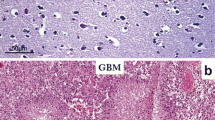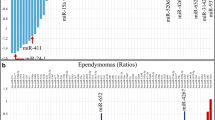Abstract
In contrast to pilocytic astrocytomas (WHO grade I gliomas) that are circumscribed and cured by surgical resection, invasion is a hallmark of grades II–IV gliomas. Proteases play a major role in the invasion process and correlations between glioma grading, survival and protease expression have been demonstrated. In this study, we have chosen to study using different technical approaches (Q-RT-PCR, in situ hybridization and immunohistochemistry) the expression of five molecules involved in extracellular matrix degradation (cathepsin B, MMP2, MMP9, uPA and PAI-1) in glioblastomas in order to determine their prognostic impact among grade IV gliomas. Pilocytic astrocytomas were used as controls. Q-RT-PCR showed that transcripts of uPA, PAI-1, cathepsin B and MMP9 were significantly more expressed in glioblastomas (n = 52), in comparison to pilocytic astrocytomas (n = 17) (P = 0.049, P < 0.0001, P = 0.03 and P < 0.0001, respectively). On both univariate and multivariate analyses, cathepsin B and PAI-1 were strong predictors of overall survival among the group of glioblastomas (P < 0.0001 and P = 0.01, respectively). Immunohistochemical expression of cathepsin B further confirmed its prognostic value in an independent cohort of patients with glioblastoma. In situ hybridization showed that uPA is detected at the invasive edge of glioblastomas, whereas PAI-1 is more abundant in microvascular proliferation and pseudo-palisading cells than at the infiltrative edges. These results suggest that cathepsin B and PAI-1 are important biomarkers for the stratification of glioblastoma patients with respect to survival.




Similar content being viewed by others
References
Bellail AC, Hunter SB, Brat DJ, Tan C, Van Meir EG (2004) Microregional extracellular matrix heterogeneity in brain modulates glioma cell invasion. Int J Biochem Cell Biol 36:1046–1069
Bindal AK, Hammoud M, Shi WM, Wu SZ, Sawaya R, Rao JS (1994) Prognostic significance of proteolytic enzymes in human brain tumors. J Neurooncol 22:101–110
Bu X, Zhang X, Cao W (1998) The expression of plasminogen activator inhibitor-1 (PAI-1) gene in human astrocytomas. Zhonghua Bing Li Xue Za Zhi 27:433–435
Caccamo DV, Keohane ME, McKeever PE (1994) Plasminogen activators and inhibitors in gliomas: an immunohistochemical study. Mod Pathol 7:99–104
Chicoine MR, Silbergeld DL (1995) The in vitro motility of human gliomas increases with increasing grade of malignancy. Cancer 75:2904–2909
Chintala SK, Tonn JC, Rao JS (1999) Matrix metalloproteinases and their biological function in human gliomas. Int J Dev Neurosci 17:495–502
Chomczynski P, Sacchi N (1987) Single-step method of RNA isolation by acid guanidinium thiocyanate-phenol–chloroform extraction. Anal Biochem 162:156–159
Claes A, Idema AJ, Wesseling P (2007) Diffuse glioma growth: a guerilla war. Acta Neuropathol 114:443–458
Colin C, Baeza N, Bartoli C et al (2006) Identification of genes differentially expressed in glioblastoma versus pilocytic astrocytoma using suppression subtractive hybridization. Oncogene 25:2818–2826
Colin C, Virard I, Baeza N et al (2007) Relevance of combinatorial profiles of intermediate filaments and transcription factors for glioma histogenesis. Neuropathol Appl Neurobiol 33:431–439
Demchik LL, Sameni M, Nelson K, Mikkelsen T, Sloane BF (1999) Cathepsin B and glioma invasion. Int J Dev Neurosci 17:483–494
Giese A, Bjerkvig R, Berens ME, Westphal M (2003) Cost of migration: invasion of malignant gliomas and implications for treatment. J Clin Oncol 21:1624–1636
Gole B, Duran Alonso MB, Dolenc V, Lah T (2009) Post-translational regulation of cathepsin B, but not of other cysteine cathepsins, contributes to increased glioblastoma cell invasiveness in vitro. Pathol Oncol Res [Epub ahead of print]
Gu J, Zhang C, Chen R et al (2009) Clinical implications and prognostic value of EMMPRIN/CD147 and MMP2 expression in pediatric gliomas. Eur J Pediatr 168:705–710
Hegi ME, Diserens AC, Gorlia T et al (2005) MGMT gene silencing and benefit from temozolomide in glioblastoma. N Engl J Med 352:997–1003
Hsu DW, Efird JT, Hedley-Whyte ET (1995) Prognostic role of urokinase-type plasminogen activator in human gliomas. Am J Pathol 147:114–123
Kelly PJ, Daumas-Duport C, Kispert DB, Kall BA, Scheithauer BW, Illig JJ (1987) Imaging-based stereotaxic serial biopsies in untreated intracranial glial neoplasms. J Neurosurg 66:865–874
Krex D, Klink B, Hartmann C et al (2007) Long-term survival with glioblastoma multiforme. Brain 130:2596–2606
Kunishio K, Okada M, Matsumoto Y, Nagao S (2003) Matrix metalloproteinase-2 and -9 expression in astrocytic tumors. Brain Tumor Pathol 20:39–45
Lah TT, Strojnik T, Levicar N et al (2000) Clinical and experimental studies of cysteine cathepsins and their inhibitors in human brain tumors. Int J Biol Markers 15:90–93
Lah TT, Obermajer N, Duran-Alonso MB, Kos J (2008) The cancer degradome; proteases and cancer biology: cysteine cathepsins and cystatins as cancer biomarkers. Springer, New York
Lakka SS, Gondi CS, Yanamandra N et al (2004) Inhibition of cathepsin B and MMP-9 gene expression in glioblastoma cell line via RNA interference reduces tumor cell invasion, tumor growth and angiogenesis. Oncogene 23:4681–4689
Landau BJ, Kwaan HC, Verrusio EN, Brem SS (1994) Elevated levels of urokinase-type plasminogen activator and plasminogen activator inhibitor type-1 in malignant human brain tumors. Cancer Res 54:1105–1108
Levicar N, Nuttall RK, Lah TT (2003) Proteases in brain tumour progression. Acta Neurochir (Wien) 145:825–838
Louis DN, Ohgaki H, Wiestler OD et al (2007) The 2007 WHO classification of tumours of the central nervous system. Acta Neuropathol 114:97–109
Marko NF, Toms SA, Barnett GH, Weil R (2008) Genomic expression patterns distinguish long-term from short-term glioblastoma survivors: a preliminary feasibility study. Genomics 91:395–406
Martinez R, Schackert G, Yaya-Tur R, Rojas-Marcos I, Herman JG, Esteller M (2007) Frequent hypermethylation of the DNA repair gene MGMT in long-term survivors of glioblastoma multiforme. J Neurooncol 83:91–93
Mikkelsen T, Yan PS, Ho KL, Sameni M, Sloane BF, Rosenblum ML (1995) Immunolocalization of cathepsin B in human glioma: implications for tumor invasion and angiogenesis. J Neurosurg 83:285–290
Muracciole X, Romain S, Dufour H et al (2002) PAI-1 and EGFR expression in adult glioma tumors: toward a molecular prognostic classification. Int J Radiat Oncol Biol Phys 52:592–598
Nakano A, Tani E, Miyazaki K, Yamamoto Y, Furuyama J (1995) Matrix metalloproteinases and tissue inhibitors of metalloproteinases in human gliomas. J Neurosurg 83:298–307
Ohgaki H, Dessen P, Jourde B et al (2004) Genetic pathways to glioblastoma: a population-based study. Cancer Res 64:6892–6899
Rao JS (2003) Molecular mechanisms of glioma invasiveness: the role of proteases. Nat Rev Cancer 3:489–501
Silbergeld DL, Chicoine MR (1997) Isolation and characterization of human malignant glioma cells from histologically normal brain. J Neurosurg 86:525–531
Stoppelli MP, Andersen LM, Votta G, Andreasen PA (2008) The cancer degradome; proteases and cancer biology: engineered antagonists of uPA and PAI-1. Springer, New York
Strojnik T, Kos J, Zidanik B, Golouh R, Lah T (1999) Cathepsin B immunohistochemical staining in tumor and endothelial cells is a new prognostic factor for survival in patients with brain tumors. Clin Cancer Res 5:559–567
Strojnik T, Kavalar R, Trinkaus M, Lah TT (2005) Cathepsin L in glioma progression: comparison with cathepsin B. Cancer Detect Prev 29:448–455
Tchoghandjian A, Fernandez C, Colin C et al (2009) Pilocytic astrocytoma of the optic pathway: a tumour deriving from radial glia cells with a specific gene signature. Brain 132:1523–1535
Acknowledgments
We are grateful to the neurosurgeons Profs. H. Dufour, F. Grisoli, J.C. Peragut, Drs G. Lena, B. Fuentes and P. Roche for providing tumor samples, to N. Dussault, A. Durand, C. Schiano, S. Gilles, P. Morando, E. Cassotte, L. Calvo, C. Cazeaux, M. Delmas and M.F. Trouche for excellent technical assistance. This work was supported by institutional grants to CRO2, by the INCA (Réseau Structurant Gliome RS019), by the INCA platform grant 2007, by the Société Française de lutte contre les Cancers et les leucémies de l’Enfant et de l’adolescent (SFCE) and by the Association pour la Recherche sur les Tumeurs Cérébrales (ARTC, ARTC Sud). Frozen samples were provided by the AP-HM TumorBank (Authorization Number 2008-70).
Author information
Authors and Affiliations
Corresponding author
Additional information
C. Colin and B. Voutsinos-Porche contributed equally to this work.
Rights and permissions
About this article
Cite this article
Colin, C., Voutsinos-Porche, B., Nanni, I. et al. High expression of cathepsin B and plasminogen activator inhibitor type-1 are strong predictors of survival in glioblastomas. Acta Neuropathol 118, 745–754 (2009). https://doi.org/10.1007/s00401-009-0592-2
Received:
Revised:
Accepted:
Published:
Issue Date:
DOI: https://doi.org/10.1007/s00401-009-0592-2




